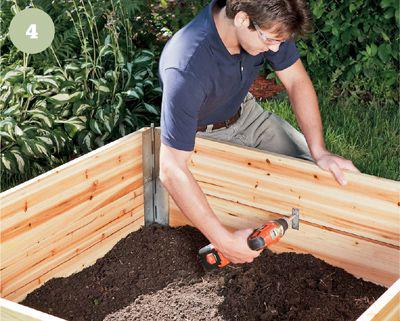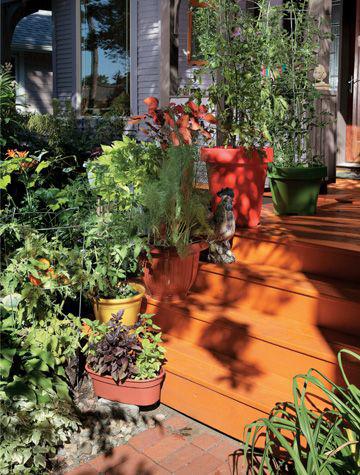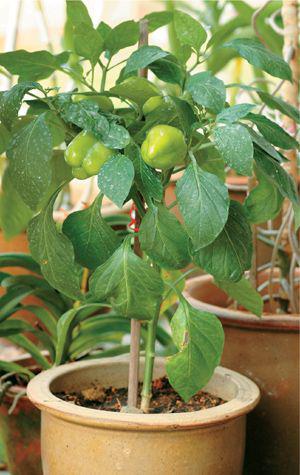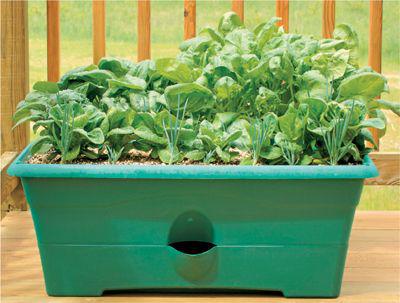DIY Projects for the Self-Sufficient Homeowner: 25 Ways to Build a Self-Reliant Lifestyle (11 page)
Authors: Betsy Matheson
Tags: #Non-Fiction

3 Set the box down,
experimenting with exact positioning until you find just the spot and angle you like. Be sure to observe the sun over an entire day when choosing the sunniest spot you can for growing vegetables. Cut around the edges of the planting bed box with a square-nose spade, move the box, and then slice off the sod in the bed area.

4 Set the bed box
onto the installation site and check it for level. Add or remove soil as needed until it is level. Stake the box to the ground with the provided hardware. Add additional box kits on top of or next to the first box. Follow the manufacturer’s instructions for connecting the modular units. Line the bed or beds with landscape fabric and fill with soil to within 2" or so of the top.

If you’re short on yard space but have a sunny spot like
a balcony, stoop, porch, roof, or even windowsill, then you have the potential to plant a productive vegetable garden. Many plants flourish in small planters or other portable containers, and with a few well-managed containers, you can yield a sizable bounty for a couple or small family. In some ways, container gardening is easier than having a full-blown vegetable garden: There are fewer weeds (if any), pests are less problematic, and diseases are easier to avoid. You also need fewer tools and plants can easily be moved to accommodate temperature fluctuations and light/shade patterns. If you’re a beginner gardener just wanting to try your hand at growing your own food, container gardening could be a great solution for you.

If you’ve never tried gardening,
container gardening is a good way to start.
Fresh soil
Do not reuse soil if you’re growing tomatoes or other plants that are susceptible to blight and fungus. After the growing season is concluded, collect the soil from sensitive plant containers and disperse it into hardy planting beds.
The key to successful container gardening is water. Because of their limited size, even the largest containers simply cannot hold the amount of water the plants need to thrive without watering once every day—extremely thirsty plants may even need to be watered more frequently than that. Vegetable plants are especially thirsty, but herbs and fruit trees or bushes need careful watering as well. Mature tomato plants may need as much as a gallon of water every day to grow those juicy, delicious fruits. If you bury your finger in the pot and you feel any dry soil—even 2" down—it’s time to water.
Soil in container gardens is important too. A reliable rule of thumb is to use a 50/50 mix of potting soil to compost. Soil from your property typically won’t hold water as well as potting soil on its own, so it’s best not to use it in container gardens without adding a significant amount of organic fertilizer, which you can buy at the garden center or mix yourself. The following pages provide guidelines about the types of containers you can use and step-by-step instructions to help you build your own planter boxes.
What to Grow
Most plants that grow well in your garden will also thrive in containers. Root vegetables are perhaps the only exception to this rule. Keep in mind that the larger the plant, the larger the container you’ll need. Generally, the plant should not be more than twice the height of the pot or 1-1/2 times as wide. Use the guidelines below as a rough guide.
Containers 4 to 6" deep:
Mustard greens, radishes, and spinach can all grow in shallow containers.
Containers at least 8" deep:
Corn (container must be at least 21" wide, however, and house at least three plants to assure pollination), kale, lettuce.
Containers at least 12" deep:
Beans, beets, brussel sprouts, cabbage (should also be pretty wide), carrots, chard, collards, kohlrabi, onion, peas, turnips, zucchini.
Containers at least 16" deep:
Cucumber, eggplant, peppers.
Containers at least 20" deep:
Broccoli, bok choy, Chinese cabbage.
More than 24" deep:
Squash, tomatoes.
 Container Types and Recommendations
Container Types and RecommendationsAs a container gardener, you’ll quickly discover that the universe of usable containers is infinitely larger than the plain clay flowerpot. Essentially, any sturdy, watertight container will do. Large containers like wine barrels or old wash tubs and smaller containers like an ice cream pail or 5-gallon bucket can all be good for different kinds of plants. Large wooden troughs and DIY planter boxes can be customized to your garden (and are fun to make, too). When building your own planters, it’s a good idea to line the inside with perforated polyethylene sheeting before adding potting soil to protect the wood from rot and to make it easier to empty out soil after a season.
Always make sure that the container you choose did not previously hold any kind of chemical and, if it does not already have them, drill drainage holes near the bottom of the container before filling with soil. If you’ll be using large containers, it’s usually
a good idea to place them on a platform fitted with casters before filling them with potting soil.
Self-watering pots make container gardening less of a drain on your time. These containers are, essentially, a flowerpot set just above a reservoir of water. With this type of container, the soil above will wick up moisture from the reservoir as it needs it—keeping the soil consistently moist throughout and eliminating the possibility of over-watering. With a self-watering container, you may only need to add water every three to four days, and your plants will likely be less stressed. Ideally, your plants will therefore provide a more sizable crop at the end of the season.

Many varieties of vegetables and fruits
can be grown in pots, planters, and other vessels—just make sure to select a container that is the right size for your plant and always add ample drainage holes if they’re not already present.

Spinach, leaf lettuce and a few shallots
co-exist in this self-watering planter. Self-watering containers have a water reservoir below to keep the soil in the pot moist. All you have to do is keep the reservoir full, and rainfall may even take care of this for you.
 Planter Boxes
Planter Boxes